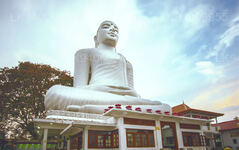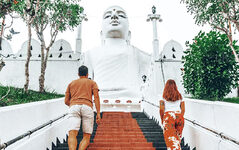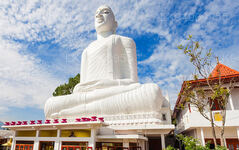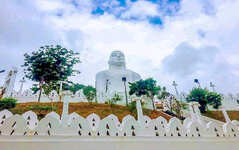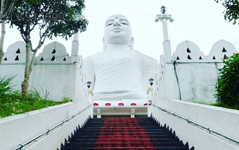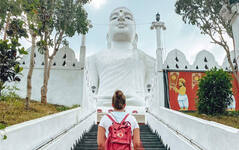
Kandy stad
Kandy, en pittoresk stad i centrala Sri Lanka, är känd för sitt rika kulturarv, sina livliga festivaler och sin vackra natur. Inbäddad bland frodiga kullar ligger Tandtemplet, ett UNESCO-världsarv, och erbjuder en fängslande blandning av historia och naturlig prakt.
Bahirawakanda Vihara Buddha Statue
Rising from a hill adjoining the holy city of Kandy is the giant Buddha statue of Bahirawa Kanda. The statue is a mere 2km from the Temple of The Tooth Relic and was built in 1972.
Folklore
Many legends surround the hill of Bahirawa Kanda which means ‘gnome mountain’; and about how this statue came to be. Chief amongst these are two stories.
The first speaks of an ancient temple to the primitive god of protection, Bahiravar; which was implanted there during the reign of the Nayakkar Kings. During the olden days in India, the standard methods of worship for this god often involved animal sacrifice; though human sacrifice was never involved. But for some reason this practice seems to have gotten twisted in the localisation process; and the priests of this temple threatened the wrath of the god unless hundreds of virgin women were sacrificed in time. The naive people of the region handed over a large number of girls for sacrifice and lived in fear of the god’s wrath. However, this came to an end when the fiance of the Chief of the Royal Mahouts was taken for sacrifice. The man, whose name was Dunuwilla Gajanayake Nilame, used his power in the palace and his bravery to get her released; and caused such a great disturbance that the sacrificing ritual was broken. This marked the end of the people’s fear and superstition; and the temple was abandoned with time.
Another story speaks of how the hill gained the name ‘Gnome Mountain’ or ‘Devil’s Hill’. According to this legend there was a time in the past when the mountain emitted strange noises and engulfed the people who lived nearby in abject fear. They believed that it was the work of an evil gnome and searched for a way to appease it. Meanwhile, unknown to anyone, an actual gnome had infilitrated the palace and taken the place of one of the ministers. Realising the opportunity; the ‘minister’ advised the king that the gnome would be appeased if a beautiful virgin was sacrificed every year, and hence a new superstition began. But then one year; the nominated sacrifice was the lover of the fake minister’s very own son. The villagers kidnapped her during the night, took her to the hill and left her there. The minister’s son discovered this in the morning and immediately set off to rescue her. He fought the gnome , his father, who had been there for his own nefarious purposes; and returned to the village. The alarmed and fearful people had begun to wonder if the rescue of the sacrifice had angered the gnome; when the cunning son quickly made a gnome sound (after all he was a gnome too, being the son of the original gnome). The people the took this to mean that the sacrifice was accepted; and the couple left the village that same night, instead of risk having their trick being discovered.
The Statue and the Sights
The Bahirawakanda Buddha Statue is located alongside the Sri Maha Bodhi Temple which is on the top of the Bahirawa Kanda hill. This beautifully sculpted white statue displays Buddha in the seated Nirvana pose and can be seen from the entire city of Kandy that sprawls out before it. It stands at 88 feet in height and is one of the biggest Buddha statues in Sri Lanka.
Visitors can climb the top of the hill for panoramic views of the City of Kandy, the inside of Bogambara Prison, and the mountain range nearby. It makes for some spectacular photographs and memories. The temple of Bahirawa Kanda is open for worship. Devotees are required to remove their hats and shoes; and can offer flowers or light oil lamps. There is also set of stairs that run behind the Buddha statue, that allow visitors to climb to a greater height for better views of the landscape. However, the best time to visit Bahirawakanda is at night, when the entire statue is lit up and the city of Kandy spreads out in a map of twinkling lights.
Om Kandy-distriktet
Kandy-distriktet ligger i den centrala provinsen i Sri Lanka. Kandy, ett av Sri Lankas sju världsarv, var en gång hem för Kandy-kungarna på 1500-talet och en källa till all musik, konst, hantverk och kultur i landet. Kandy ligger cirka 129 km från Colombo och ligger i en kuperad terräng och alla blickar dras till stadens centrum, där Kandysjön utgör ett charmigt inslag. Kandy har fortfarande stor religiös betydelse för Sri Lanka, eftersom det är i denna charmiga stad som Dalada Maligawa eller "Tandtemplet" ligger, i vilket Buddhas heliga tandrelik ligger välbevakad. Den kungliga botaniska trädgården i Peradeniya ligger cirka 5 km väster om stadens centrum i Peradeniya och besöks av 1,2 miljoner människor per år. Det är den största botaniska trädgården på ön. Udawatta Kele (Udawatta-skogen) är ett skyddat fristadsområde beläget i hjärtat av staden, strax norr om Tandtemplet. Kandy är en stad med majoritets singalesiska invånare; det finns stora samhällen som tillhör andra etniska grupper, såsom morer och tamiler. Kandy är näst efter Colombo, centrum för Sri Lankas ekonomi. Många större kooperativ har stora filialtjänstemän i Kandy och många industrier, inklusive textilier, möbler, informationsteknik och smycken, finns här. Många jordbruksforskningscentra finns i staden. Och en källa till all musik, konst, hantverk och kultur i landet. Cirka 129 km från Colombo ligger Kandy inbäddat i en kuperad terräng och alla blickar dras till stadens centrum, där Kandysjön utgör ett charmigt inslag. Kandy har fortfarande stor religiös betydelse för Sri Lanka, eftersom det är i denna charmiga stad som Dalada Maligawa eller Tandtemplet ligger, inom vilket Buddhas heliga tandrelik ligger välbevakad.
Om Centralprovinsen
Centralprovinsen i Sri Lanka består huvudsakligen av bergig terräng. Provinsen har en yta på 5 674 km² och en befolkning på 2 421 148. Några större städer inkluderar Kandy, Gampola (24 730), Nuwara Eliya och Bandarawela. Befolkningen är en blandning av singaleser, tamiler och morer. Både bergshuvudstaden Kandy och staden Nuwara Eliya ligger inom Centralprovinsen, liksom Sri Pada. Provinsen producerar mycket av det berömda ceylonteet, som planterades av britterna på 1860-talet efter att en förödande sjukdom dödat alla kaffeplantager i provinsen. Centralprovinsen lockar många turister, med bergsstäder som Kandy, Gampola, Hatton och Nuwara Eliya. Tempeltand eller Dalada maligawa är den viktigaste heliga platsen i Centrelprovinsen. Klimatet är svalt, och många områden på cirka 1500 meters höjd har ofta kyliga nätter. De västra sluttningarna är mycket våta, och vissa platser har nästan 7000 mm regn per år. De östra sluttningarna är delar av den mellantorra zonen eftersom det endast regnar från nordöstra monsunen. Temperaturerna varierar från 24 °C i Kandy till bara 16 °C i Nuwara Eliya, som ligger 1 889 m över havet. De högsta bergen i Sri Lanka ligger i Centralprovinsen. Terrängen är mestadels bergig, med djupa dalar som skär in i den. De två huvudsakliga bergsregionerna är det centrala massivet och Knuckles-bergskedjan öster om Kandy.

